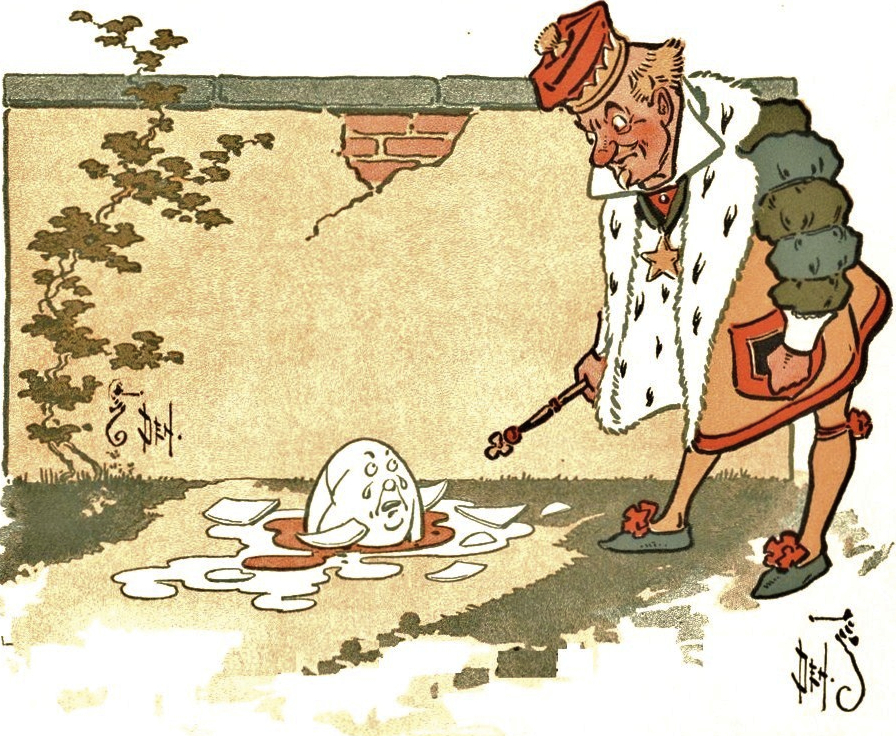
W. W. Denslow (Wikimedia Commons)
All the king's horses and all the king's men couldn't put Humpty together again.
Eat Whole Grains, Not Humpty Dumpty
by Susan Lesch. November 8, 2015
Do you need an alternative to the gluten-free craze? The history of refined grain is scattered with familiar names. Here we will whiz through sixty years in one paragraph.
Spurred on by Good Housekeeping and the Journal of the American Medical Association, the 19th century Pure Food movement favored whiteness for purity in flour. Worries about foodborne illness brought us packaged bread by 1920. Marion Nestle and Malden Nesheim write that Minneapolis millers "routinely dumped" bran into the Mississippi. Washburn Crosby tried diversification as early as 1923 when they sold whole wheat flour. But James Ford Bell liked to provoke thought by saying that flour is "an adjunct of the feed business." In 1928 when he formed General Mills, their daily capacity was more than 80,000 barrels of flour, plus almost 6,000 tons of feed. (In first quarter 2015, the U.S. produced 1.6 million tons of feed alongside 103 million cwts of flour: 1 ton of feed per 3.2 tons of flour.) Around 1940, responding to a great need for nourishment among Americans, and helping to wipe out beriberi and pellagra, General Mills decided to enrich flour, based on their Vibic Flour formula.
Most vitamins were first proposed and synthesized between 1901 and 1943. Proponents of fortification claim victories, but it is too soon to pat ourselves on the back in congratulations. In the story of Humpty Dumpty, the king's men of enrichment can't ever restore a processed grain into a whole one.
Less than 10% of Americans' grain intake is whole grains, and 99% of us eat less whole grain than recommended, yet five years ago, whole wheat bread outsold white for the first time. (My grocer tripled their order of a whole grain bread, and it still sells out.) Nationwide, whole wheat is about 6.3% of flour production, up from 5.2% in 2014. So why ship our bran out for animal feed? Is enriched flour's shelf-stability a fair substitute? Why are refined grains impossible to escape: in the Starbucks display case, donut shops, vending machines, the Food Network, Panera Bread, convenience stores, burger buns, pasta and pizza? Harvard says processing "strips away more than half of wheat's B vitamins, 90 percent of the vitamin E, and virtually all of the fiber."
Thirty percent
By following the Dietary Guidelines for Americans (depending on caloric needs, 3 to 10 daily grain servings, at least half of them whole), we could receive tremendous benefits from whole grains. We have one review but insufficient studies on the effect of eating all our grains whole. No cause and effect relationship can be drawn here, but studies of partial whole grain intake are nevertheless persuasive. Recently, a review of the HELGA study of 120,000 Scandinavians found 1% to 17% lower mortality for each doubling of intake of whole grains.
The Harvard/Chan School of Public Health lists other benefits, simplified here, which I like to remember as the "30 percent" list. (It contains several reviews and meta-analyses of the Iowa Women's Health Study, the Nurses' Health Studies I and II, and the Health Professionals Follow-Up Study, with results measured over 17, 10 and 18 years, and compared to those who ate less than 1 serving or less than 2 servings of whole grains per week.)
Harvard says women who ate 2 or 3 servings of whole grains daily were 30 percent less likely to have a heart attack or die from heart disease, 30 percent less likely to have type 2 diabetes, and 30 percent less likely to die from an inflammation-related condition. Men and women increased their risk of diabetes by 17 percent when they ate white rice five times per week. Researchers think diabetes risk can be reduced 36 percent by replacing at least some white rice with brown rice. Also, the fiber in whole grains prevents constipation and helps digestive health.
Cereal aficionados might recall that in 2004, Denmark banned the sale of Kellogg's enriched cereals except by permit, because they believed the added vitamins and minerals are harmful to people who eat a balanced diet. Maybe it is no wonder that the lead author of the recent HELGA review works in Denmark and that her research suggests eating whole grains could delay our deaths. Instead of making only one whole grain product eligible, Pillsbury could get the ball rolling and solicit Bake-Off Contest recipes for whole grain treats. Just for starters, Harvard and the Culinary Institute of America got together and published "The Great Muffin Makeover."